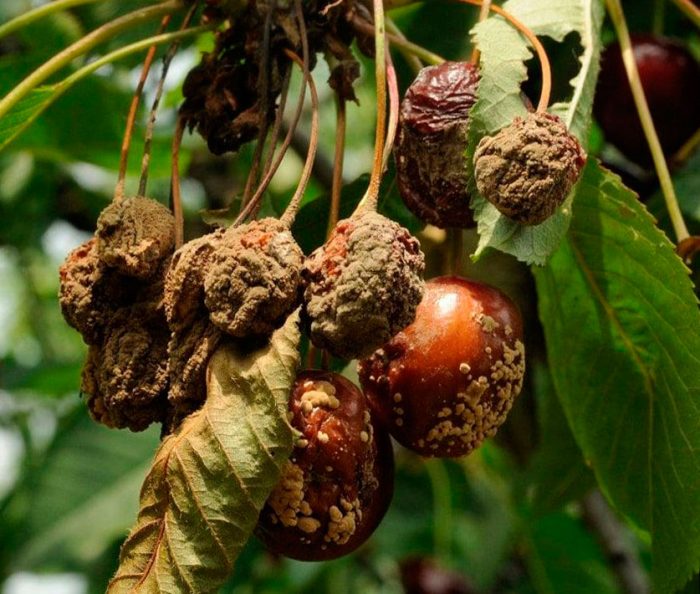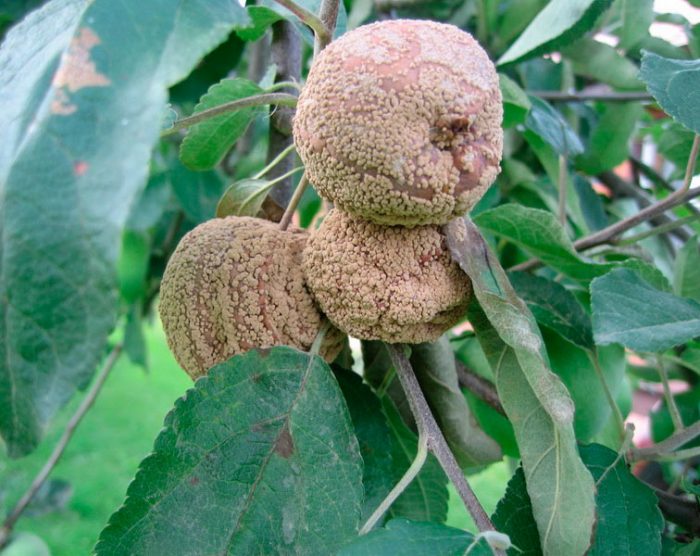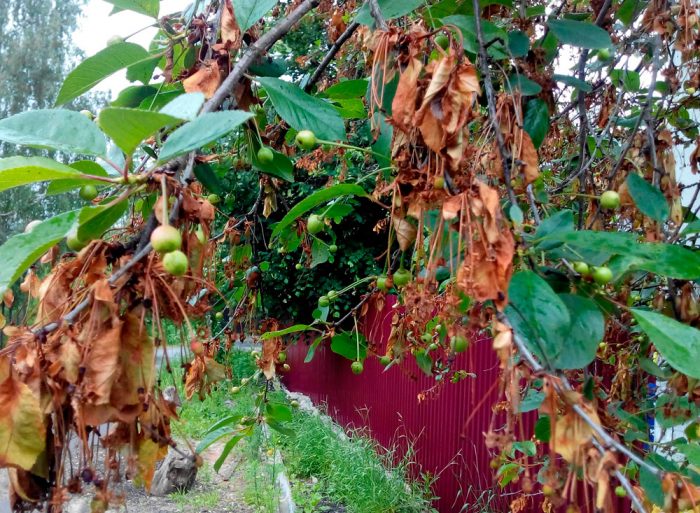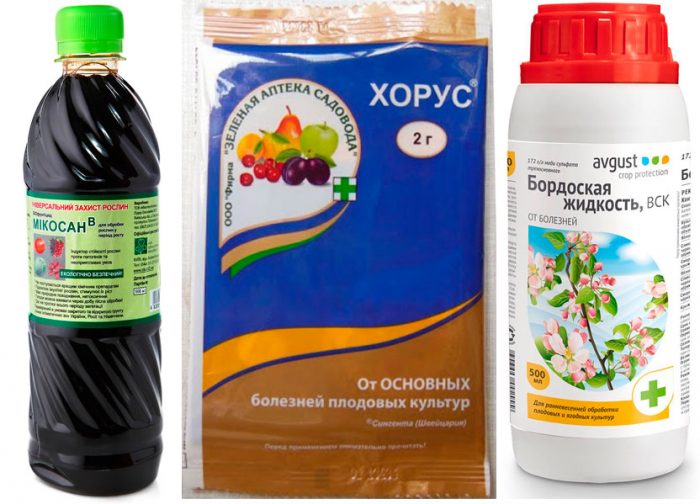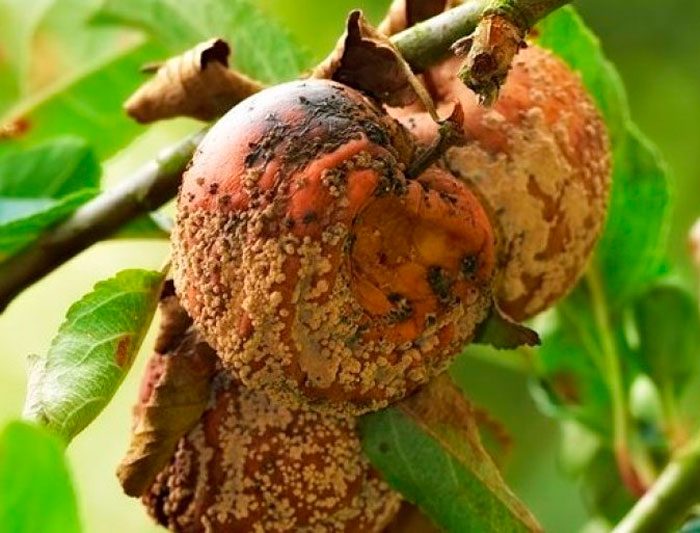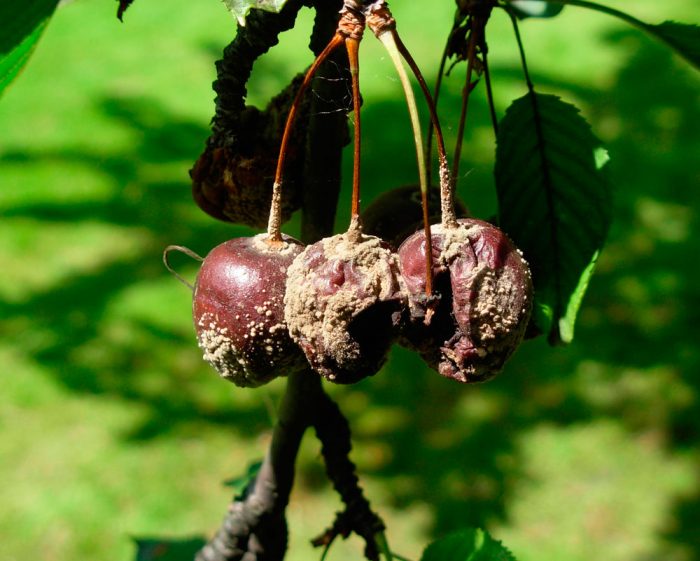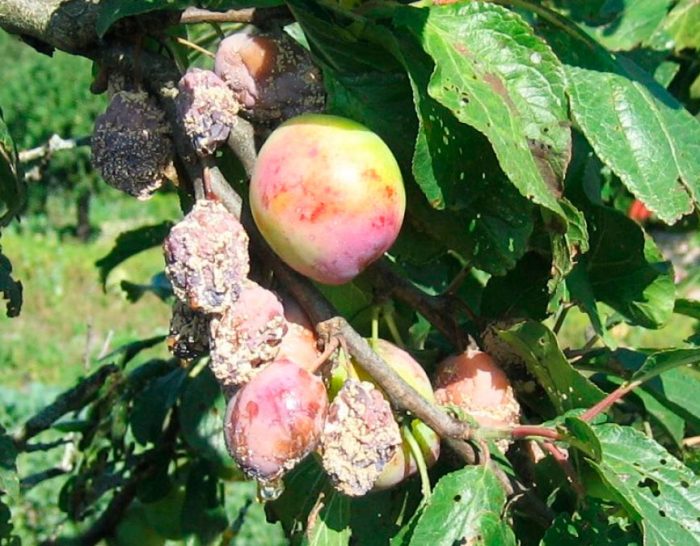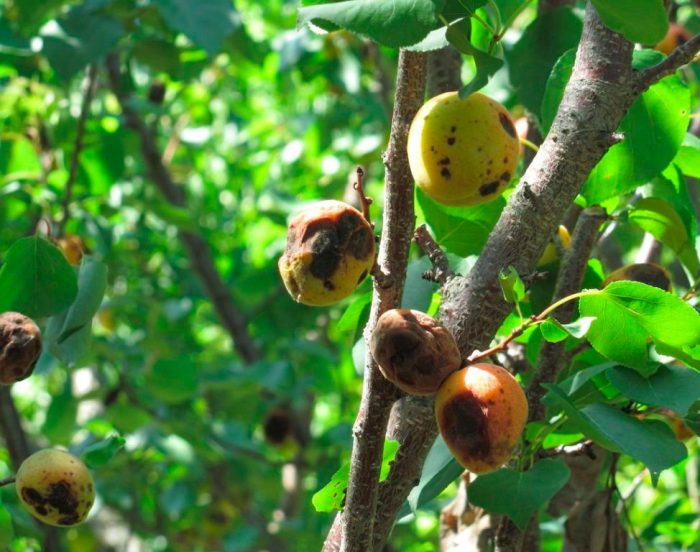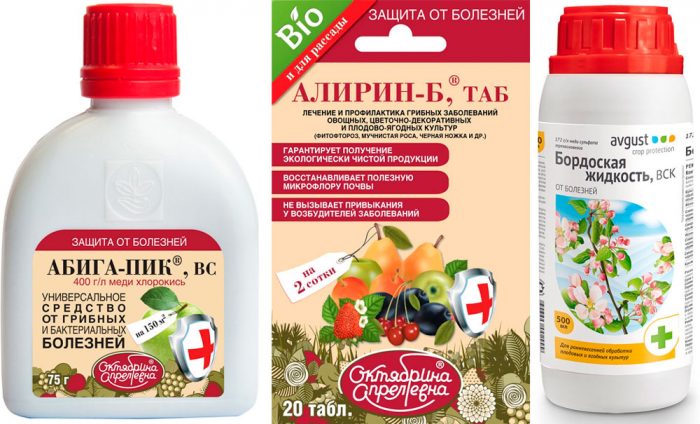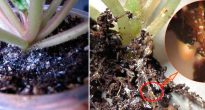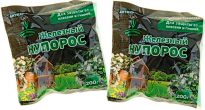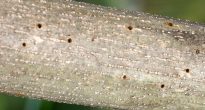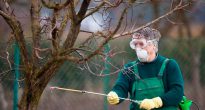The causative agent of such a fungal disease as moniliosis, or fruit rot, or monilial burn is the ascomycete Monilia. This disease is widespread in areas with a temperate climate, especially in those regions where the spring is damp and cold. Most often, monilial burn affects fruit crops:
- stone trees are infected by the pathogen Monilia cinerea;
- pome trees - the causative agent of Monilia fructigena;
- quince is the causative agent of Monilia cydonia.
Content
Features of moniliosis
Most often, the causative agent of moniliosis affects the plant during the flowering period. It can enter the plant through the bark, and its incubation period lasts about 15 days. Then the flowers and foliage gradually drill and wilt until they eventually die. On the leaf petioles and pedicels, in warm and damp weather, very small white pustules appear on the underside, in which there are fungal spores. The carriers of these spores are garden pests and the wind, falling on healthy plants and trees, they infect them with moniliosis, which is why brown specks form on the surface of the fruits, which, as the disease progresses, increase in size until they cover the entire surface. In the affected fruit, the flesh becomes soft, turns brown, and at the same time it has an alcoholic aftertaste. After 1-1.5 weeks after the defeat of the fetus, small creamy pads appear on its surface (these are sporodochia). Over time, mummification of the affected fruits occurs, in which there are sclerotia or mycelium, and they can both fall to the ground and remain on the branch of the plant until spring.
The disease develops most actively under the following conditions: the air temperature is from 15 to 20 degrees, and its humidity is from 95 to 100 percent. In the middle latitudes, this disease is found everywhere.
Moniliosis treatment
To get rid of moniliosis, an integrated approach will be required, including proper care, agricultural rules, preventive measures, as well as chemicals and folk remedies. In order to protect plants from being affected by this disease next year, when the growing season ends, it is necessary to remove all affected fruits from the site, cut out diseased stems and shoots, and be sure to destroy all this with fire.And also, shortly before the beginning of the dormant period, the base of the skeletal branches and the stem of fruit trees are whitewashed with a solution of lime, to which a fungicidal preparation is added. During the growing season, regularly inspect trees and at the first symptoms of moniliosis, immediately begin to fight the disease. For this, fruit crops are treated with a special agent that can destroy the causative agent of the disease. However, before proceeding with processing, all diseased stems and branches are cut out, and the affected fruits are also cut off, after which it is all necessarily destroyed.
Preventive measures
Many gardeners know that it is much easier to prevent any disease than to fight it later. This also applies to moniliosis, since the best method of dealing with it is prevention. What can you do to protect your garden from this fungal disease? The main measures for the prevention of moniliosis:
- When planting seedlings, try to maintain a distance between them, which is recommended by experts. If trees grow too close to each other, then because of this they will be much worse blown by the wind, which has a positive effect on the spread and development of pathogenic microorganisms.
- For tree planting, choose a location that is well ventilated.
- Protect plants from mechanical damage, as through them moniliosis pathogens and other pathogenic microorganisms can easily penetrate the tree. Therefore, all frost holes and wounds must be treated and covered up in a timely manner.
- Remember to prune on time. When removing branches affected by the disease, be sure to grab some healthy tissue, and do not forget to treat all the cut points with garden varnish.
- In winter, there should be no diseased fruits on the branches of the tree. They are cut off and destroyed along with the cut off stems and branches that are affected by the disease.
- Conduct timely control of pests that injure the bark and aerial parts of fruit crops. Also, do not forget to destroy their larvae.
- In the autumn, carry out a mandatory digging of soil in the tree trunk circles.
- When feeding plants, carefully monitor the amount of fertilizer applied and do not allow either a deficiency or an excess of nutrients.
- Only disinfected garden tools can be used to work with fruit trees.
- Experts advise that for growing in a garden plot, choose those varieties of trees that are highly resistant to pests and diseases.
Also, one of the main preventive measures is regular treatment with special chemicals, which are carried out before flowering. To treat plants on foliage, solutions of such agents as Mikosan-V, Horus, Bordeaux liquid (1%) are used; other fungicidal preparations, which include copper, can also be used. Repeated prophylactic spraying is carried out immediately after the tree has faded, then treatment with a fungicidal preparation is carried out in July 1 or 2 times. In autumn, after harvesting, the plants are also sprayed 1 or 2 times with products containing copper.
Moniliosis on pome and stone fruit crops
Pears and apple trees
Moniliosis poses a great danger to stone fruit crops, because the affected fruits cannot be used for food. Plants in this case are attacked by conidia Monilia fructigena. You can understand that an apple tree or a pear is affected by this disease by the following signs: first, a brown speck of a round shape appears on the surface of the fruit, then its rapid increase in size occurs. As a result, this spot covers most of the fruit or its entire surface entirely. The affected fruit turns brown and the flesh becomes tasteless.
Also, these cultures can be affected by moniliosis, which manifests itself in the form of a burn, its pathogens are the conidia Monilia cinerea. In the affected tree, flowers, branches, ringlets, and twigs become brown and dry. As a rule, active damage to plants by a monilial burn is observed if a lot of snow fell in winter, and spring was long, cold and damp.
In order to prevent the defeat of pears and apple trees by moniliosis, during the entire growing season, it is necessary to collect fallen and dried fruits, as well as cut off the affected branches and stems. Both the harvested diseased fruits and the cut branches are necessarily destroyed by fire. Do not forget about preventive measures that will help prevent mechanical damage to the fruit. Spray plants regularly and in a timely manner against both pests and diseases. Also, for preventive purposes throughout the growing season, pears and apple trees are sprayed with solutions of fungicidal agents, for example, you can use: Horus, Strobi, Abiga-Peak, Gamair, Alirin-B or Planriz. Also remember about the rules of agricultural technology for these crops and be sure to adhere to them.


Watch this video on YouTube
Sweet cherries and cherries
Moniliosis affects not only cherry, but also the following stone fruit crops: plum, apricot, cherry plum and peach. This disease is caused by the fungus Monilia cinerea, which hibernates in mummified fruits or affected branches. In this regard, with the onset of spring, branches that have died from a monilial burn are mistaken by many gardeners for freezing in winter.
In sick cherries and cherries, wilting and drying of flowers, fruit branches, as well as foliage is observed, and non-lignified young shoots outwardly look as if they were burned by fire. During the flowering period, spores of the fungus caught on the pistil successfully germinate and cause vascular damage.
And on pome and stone fruit trees, the development of this disease can occur in two forms: as fruit or gray rot and as a monilial burn. First of all, there is rotting damage to those fruits on which mechanical damage is present. On such fruits, dark specks are formed, which rapidly increase in size. As a result, spots can cover the entire surface of the fetus, and as the disease develops, pads with spores form on it. Over time, wrinkling and drying of such fruits is observed.
Pathogenic fungi, which are the causative agent of this disease, are able to overwinter in diseased aerial parts of the plant. And with the onset of spring, fungi manifest themselves as spores that fall on healthy trees located in the neighborhood, due to rain, gusts of wind or pests. However, it is through the pistil that the primary defeat of the tree occurs, after which the mycelium penetrates through the peduncle into the bark and wood, and its partial destruction is observed. As a result, moisture ceases to flow into the affected part of the branch. As the disease progresses, the diseased part of the branch above the site of penetration of the fungus dries and dies. Having cut off a branch affected by moniliosis, dark-colored rings can be seen in place of its cut.
Inspect the trees and cut off all the branches that have begun to dry out, and it is imperative to grab from 10 to 15 centimeters of healthy tissue, and diseased fruits are also cut off. These plant residues must be destroyed by fire in order to prevent further spread of the disease. Plants affected by moniliosis, as well as those trees that are nearby, are sprayed with a solution of Bordeaux liquid or drugs such as Horus, Cuproxat, Fitosporin-M, Abiga-Peak, Topsin-M or Fitoflavin. Spraying should be carried out on a calm, fine day.
So that when growing cherries in your garden you definitely do not encounter moniliosis, for planting it is recommended to choose varieties that are highly resistant to this disease, for example: Anadolskaya cherry, Shokoladnitsa, Alexa, Tamaris, Novella, Brunetka, Nochka, Shalunya, Bystrinka, Turgenevka, Octave, In Memory of Vavilov and Shpanka Krasnokutskaya. Note that felt cherries and varieties such as Vladimirskaya and Lyubskaya are extremely susceptible to this disease.
Plum
Signs of damage to plums with moniliosis are very similar to those that appear on other fruit trees, namely: the fruits become brown, and sporulation pads form on their surface, while the foliage, branches and flowers dry up and look like they have been burnt by fire. Cracks appear on the surface of old branches, from which gum begins to flow, eventually forming sagging. Please note that with fruit rot on the surface of the fruit, the sporulation pads are placed randomly, and with gray rot, they form concentric circles.
You can cure a plum affected by moniliosis in the same way as a cherry, a pear, an apple tree or a sweet cherry. Do not forget to take all the necessary preventive measures that will help prevent pests (moths, weevils, geese, etc.) from appearing on the drain, protect plants from mechanical injury, and collect and destroy branches and fruits affected by the disease in a timely manner. Preventive spraying of such a tree, as well as the surface of the soil under it, is carried out before the flowers open on it, for this they use a 1% solution of Nitrafen, Bordeaux mixture or copper sulfate. As soon as the tree fades, a repeated preventive treatment is carried out, and this time a solution of Bordeaux mixture, Kaptan, Tsineb or Kuprozan is used. In the summer, the plum is sprayed with one of the listed agents again, but in this case, you cannot use the Bordeaux mixture, as it can cause burns on the foliage. In the autumn, preventive treatment of plants with copper sulfate or Nitrafen is carried out, however, it is best to use a urea solution (7%) for this purpose. In autumn, the base of the skeletal branches and the stem of the plant are whitened with a solution of lime mixed with a fungicidal preparation.


Watch this video on YouTube
Peach and apricot
Moniliosis also affects apricots and peaches. In May, near a diseased tree, you can find flown flowers and ovaries, in June, drying of branches is observed on these plants, after a short time darkening and wilting of the foliage occurs, and the fruits become brown. If you examine such trees more carefully, then on the surface of the branches you can find cracks and formed influxes of gum, and on the fruits - pads with spores of a cream or grayish color. As a result, the diseased plant gives a meager harvest, and only a small part of the fruits remains healthy, however, they burst after a while, without having time to ripen.
Damage to such trees by moniliosis occurs in the same way and under the same conditions as in other fruit trees. In order to prevent the disease from affecting apricot or peach, one should strictly adhere to the agrotechnical rules of the culture, provide them with good and proper care, and cut them regularly. For prophylactic purposes, before the flowers open on the tree and as soon as it fades, and 1 or 2 times in June and July and the same number of times after harvest, the trees are treated with fungicidal agents such as: Bordeaux mixture, Horus , Mikosan-V, you can also use other drugs of similar action.It is very important to timely and regularly process the plants in late autumn, in this case the effectiveness of the first spraying carried out in the spring will be much higher. For prevention purposes, do not forget to conduct a systematic inspection of plants and pruning of affected branches, and be sure to grab a few centimeters of healthy tissue. In autumn, all diseased fruits, as well as cut branches, must be destroyed by fire. Also, digging of near-trunk circles is carried out.
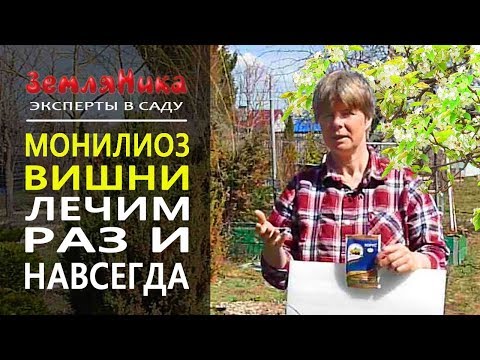

Watch this video on YouTube
Preparations for moniliosis (fungicides)
In order to cope with moniliosis on fruit trees, the following fungicidal agents are used:
- Abiga Peak... Broad spectrum contact agent containing copper. It is used to treat bacterial and fungal diseases.
- Alirin-B... This biological preparation is used to treat soil and plants and has the ability to suppress fungal diseases. It is used as a protective and therapeutic agent.
- Bordeaux liquid... Contact agent with a wide spectrum of action.
- Gamair... This preparation of biological origin is used to treat soil and plants in the fight against some bacterial and fungal diseases.
- Captan... This broad-spectrum contact agent is used to treat fruit trees to prevent moniliosis, scab and black spot.
- Cuproxat... The contact drug is used for both protective and medicinal purposes. It is effective in combating a whole range of fungal diseases.
- Copper sulfate... A broad-spectrum contact agent that contains copper is used to treat fungal diseases on pome and stone fruit trees.
- Mikosan-V... The action of this biological agent is to stimulate the plant's immunity.
- Nitrofen... It is an enteric insecticidal, fungicidal and herbicidal agent that is used to protect plants from fungal diseases.
- Planriz... Such a preparation, created on the basis of soil bacteria, is characterized by environmental safety and high efficiency.
- Strobe... With a broad spectrum of action, the agent is highly effective; it is used to treat ornamental, fruit and vegetable crops against fungal diseases.
- Topsin-M... The systemic drug is used to treat and prevent fungal diseases. Differs in high efficiency in preventive spraying.
- Phytoflavin... Biological bactericide of systemic action is used for the prevention of most bacterial and fungal diseases.
- Fitosporin-M... Biological contact drug. This microbiological agent is used to prevent a whole range of fungal and bacterial diseases.
- Horus... This systemic agent is used to prevent diseases such as: moniliosis, scab, etc.
- Tsineb... The tool is used to treat and prevent fungal diseases.
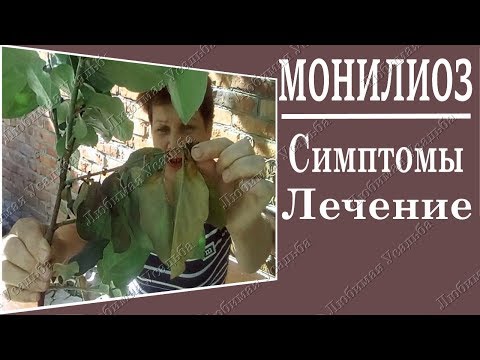

Watch this video on YouTube
Folk remedies for combating moniliosis
In the fight against moniliosis, gardeners very often use such a folk remedy as urea solution. To prepare it, 10 liters of water are combined with 1 kilogram of urea, this amount is enough to process two adult trees. To make such a folk remedy better adhere to the plant, 40 mg of dishwashing detergent is dissolved in it. When spraying, try to get all branches and all foliage wet, both sides of it. When in autumn all the leaves fly from the tree, they must be covered with a thick layer of straw in the near-trunk circle.The urea solution destroys the fungus, removing it from both branches and foliage, and a mulch layer of straw is able to preserve those pathogens in the soil that could survive during treatment. In addition, straw can protect the root system of the tree in winter from freezing. In early spring, even before sap flow begins, if desired, you can carry out another treatment of plants with a urea solution.

